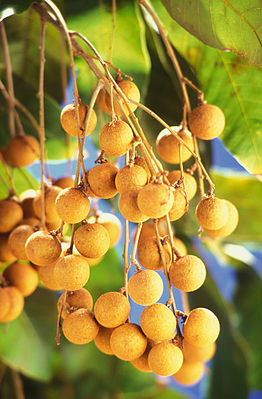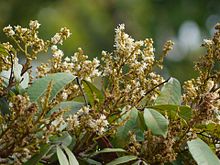Longan
| Longan tree | ||||||||||||
|---|---|---|---|---|---|---|---|---|---|---|---|---|

Longan fruits in a fruit cluster on the longan tree |
||||||||||||
| Systematics | ||||||||||||
|
||||||||||||
| Scientific name | ||||||||||||
| Dimocarpus longan | ||||||||||||
| Lour. |
The longan tree ( Dimocarpus longan ) is a plant from the genus Dimocarpus within the family of the soap tree plants (Sapindaceae).
etymology
The name Longan is said to come from the Vietnamese city of Long-An, where Longans are still cultivated today, and primarily refers to the fruits . These are called in Chinese 龍眼 , lóngyǎn , but also guiyuan ( 桂圓 ), in Cantonese long-ngan (lit .: " dragon eye "), Lengkeng in Indonesia, Mata Kucing (lit. "cat's eye") in Malaysia , Lamyai ( ลำไย ) in Thailand , nhãn in Vietnamese (the species Euphoria longana Lamk. is called in Vietnamese "long nhãn" - literally "dragon eyes"), Mora in Sinhala ( Sri Lanka ) and in Tagalog also "Longan".
description
Vegetative characteristics
Dimocarpus longan grows as an evergreen tree that reaches heights of growth of 10 to a rare 40 meters and a trunk diameter of around 1 meter or more.
The alternate leaves are arranged in petioles and leaf blades and are at least 15 to 30 centimeters long. The imparipinnate leaf blades usually contain four or five (rarely three or six) pairs of leaflets. The stems of the egg-shaped to -lanzettlichen or lanceolate to reversed-eilanzettlich pinna leaflets are shorter than 5 millimeters. The somewhat leathery, glabrous and entire leaflets are often asymmetrical, 6 to 15 centimeters long and 2.5 to 5 centimeters wide. They are shiny on top and rounded to pointed at the tip, and pointed to wedge-shaped at the base. The cotyledons ( cotyledons ) thick.
Generative characteristics
The terminal or axillary, large and paniculate inflorescences are strongly branched and finely haired. The functionally unisexual, short-stalked flowers are radial symmetry with a double flower envelope . The five cup-shaped, almost leathery sepals are about 2.5 millimeters long and have brownish woolly hair on both sides. The five petals are milky white and almost the same length as the sepals. In the male flowers there are eight stamens with hairy stamens or in the functional female flowers, short staminodes. The ovary is on top, the stigma has two to three lobes. There is a discus . A pestle can be formed in the male flowers.
The mostly yellowish-brown or sometimes grayish-yellow, almost spherical, more or less scabby-blackish fruit has a diameter of 1.2 to 3 centimeters. The seeds have a whitish, fleshy and translucent arillode . The fruits have a sweet, very aromatic taste and their pulp is similar to the lychees , which are just as white and very juicy, but have a different taste of their own. Similar to the grape , several fruits hang on a fruit cluster. Inside every fruit, whose brittle, slightly leathery, inedible skin is most conveniently opened by pressing between thumb and forefinger, there is a shiny, dark red (like the lychee) to black hard core and seeds. The size of the fruits is comparable to that of large grapes or cocktail tomatoes and is slightly smaller than the size of lychees.
distribution
The original range of Dimocarpus longan extends from Sri Lanka , India , Myanmar , Laos , Cambodia , Thailand , Vietnam through the Chinese provinces of Guangdong , Guangxi , Hainan and Yunnan to Malaysia , Indonesia and the Philippines . For example, it is a neophyte in New Guinea . It is grown , for example, in southern China as well as Taiwan and many other subtropical areas. Longans (here called longaniers) are also popular on Réunion (French overseas department), where they replace the related lychee in their harvest season.
Systematics
The first publication of Dimocarpus longan was in 1790 by João de Loureiro in Flora cochinchinensis: sistens plantas in regno Cochinchina nascentes. Quibus accedunt aliæ observatæ in Sinensi imperio, Africa Orientali, Indiæque locis variis. Omnes dispositæ secundum systema sexuale Linnæanum. Ulyssipone. 1, p. 233. Synonyms for Dimocarpus longan Lour. are: Euphoria longan (Lour.) Steudel , Euphoria longana Lam. , Nephelium longana (Lam.) Cambessèdes .
use
The longan fruits are used fresh for soups , sweet and sour dishes, snacks and desserts , but can also be preserved very well. Longans are usually dried in the sun, but sometimes also with smoke. During the drying process, the pulp detaches from the skin and wraps around the core. To eat the dried fruit, the then brittle skin is removed and the core with the dried fruit pulp is sucked. Also is from sun-dried longans lemonade made.
In addition to fresh fruit, longans are peeled and pitted in cans in Europe. The sweetness of canned fruits preserved in 'Light Syrup' corresponds to that of fresh fruits, even if they do not quite achieve their taste. It should be noted that, depending on the case, preserved longan canned fruits can also be sweetened by adding sugar.
literature
- P. Acevedo-Rodríguez, PC van Welzen, F. Adema, RWJM van der Ham .: Sapindaceae. In: K. Kubitzki : The Families and Genera of Vascular Plants. Vol. X: Flowering Plants Eudicots , Springer, 2011, ISBN 978-3-642-14396-0 , pp. 357-407, online (PDF; 1.7 MB).
Individual evidence
- ↑ a b c d e f g Nianhe Xia, Paul A. Gadek: Sapindaceae. : Dimocarpus longan , p. 15 - online with the same text as the printed work , In: Wu Zheng-yi, Peter H. Raven, Deyuan Hong (ed.): Flora of China . Volume 12 - Hippocastanaceae through Theaceae , Science Press and Missouri Botanical Garden Press, Beijing and St. Louis, 2007, ISBN 978-1-930723-64-1 .
- ^ The Van Pham, MH Tran, H. Herrero, J. Hormaza: The reproductive biology of the Longan. Proceedings of the 5th National Scientific Conference on Ecology Biological Resources, Ha Noi, Vietnam 2013, pp. 1242-1246, online at researchgate.net.
- ↑ a b c Story about Thailand by Wilfried Stevens: The Thai land fruits Longan: lamyai ( Memento from April 4, 2017 in the Internet Archive ).
- ↑ Longanis: Fruits de la Reunion. In: reunionsaveurs.com. Retrieved February 27, 2020 (French).
Web links
- Longan at Growables, accessed October 6, 2019.
- Dimocarpus longan at Useful Tropical Plants.
- Longan at Plant Lexicon.
- Dimocarpus longan inthe IUCN Red List of Threatened Species 2013.2. Listed by: World Conservation Monitoring Center, 1998. Retrieved May 3, 2014.



